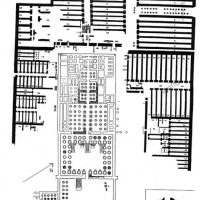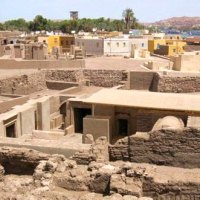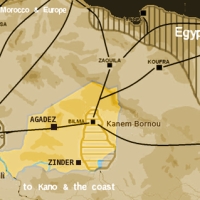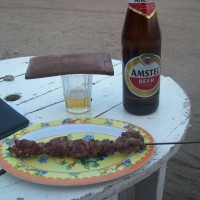
Above are but two of a series of words that originated in the Nile Valley. The reasons for these survivals is perhaps not such a surprise, as discussed below.

The word ‘ebony’ is found from earliest times in the Nile Valley. Here are the different forms of writing and descriptions. Source: Oriental Institute, Chicago
‘Ebony’ as named and used in ancient Egypt, was the species Dalbergia melanoxylon (African Blackwood, Grenadilla, or Mpingo). This is a slow-growing leguminous hardwood, originally found in southern Ethiopia and areas south and west, but now endangered and no longer found in many regions.
Ebony was – and continues to be – an elite wood, used in the past by pharaoh and perhaps also by the very wealthy. In fact, one of the earliest discovered artifacts made of this wood is a piece on which is inscribed, in pictures, key events of the life of Den, the third pharaoh of ancient Egypt, approximately mid-thirty-first century BC.

Ebony label depicting the pharaoh Den, found in his tomb in Abydos (southern Egypt) c. 3100 B.C. This is the first known depiction showing the Pharaoh wearing the double crown and showing his name (‘dn’) written in a serekh (representation of a palace facade) with a horus-hawk above. Also, in running in the so-called sed festival, a commemoration of his rule that continued to be enacted by pharaohs throughout several thousand years of Egyptian history. Picture source: Wikipedia
Evidence of ebony at this early period attests to what must have been an active, long-distance trade between areas of greater Nile valley and possibly sub-Saharan Africa that would have been controlled by pharaoh and his representatives.

‘Hbny’ (‘Ebony’), pet puppy of Thutmose III, 18th. Dynasty, 1473-1458, resting under the pharaoh’s chair, beside pharaoh’s leg. The hieroglyphic writing of ‘hbny‘ is explained in the above depiction from the Oriental Institute, where the word is written from left to right, rather than right to left – as here (either way was perfectly acceptable in ancient Egypt). Tomb painting reproduced by Nina de Garis Davies. Source: Met. Museum
.The fact that it is not a species indigenous to Egypt or North Africa, and that it was (and continues to be) of high economic value, helps to explain the continued use of the word ‘ebony’ for over 3000 years – and (although not included in the first picture, above) – a variant is also used in the Arabic language: خشب الأبنوس (khashab ‘ibnuus‘ – literally, ‘ebony wood’)


Bébé on an elephant. One of three ebony elephants, made over 50 years ago, that were given to me by an old Belgian colonial couple who were leaving Burundi ‘for good.’ The elephants were probably made in Kenya or Tanzania. They are extremely heavy.
Prospects for African hardwood as an agroforestry crop for smallholders:

Mpingo (African hardwood) tree, the national tree of Tanzania. Source: peterworrell.co.uk
Known is kiswahili as ‘mpingo,’ the tree is leguminous and therefore helps to replenish soils. As well, leaves and pods provide fodder for wildlife and livestock, and the roots are used “…in traditional medicines to treat abdominal pain, diarrhoea and syphilis; the wood smoke is inhaled to treat headaches and bronchitis..” (World Agroforestry Centre).
Being extremely dense, the wood can burn at such a high heat as to melt metal pots, and mature trees are tolerant of brush fires. The wood is valuable in handicraft production and also is considered by many the best for making of woodwind instruments.

African blackwood is favored in woodwinds. Hm. I played the clarinet at one time, and had a metal instrument because the wooden instrument was just too expensive.
The bad news, however, is that the tree takes several decades to reach full maturity – not a good bet for the majority of smallholders who are looking to grow fast turn-around agroforestry species in their farms.
Here are several interesting links about African Blackwood:
-
http://www.arkive.org/african-blackwood/dalbergia-melanoxylon/image-G5132.html
-
http://www.peterworrell.co.uk/africanblackwood.htm
-
http://sauerandsteiner.blogspot.com/2009/04/introduction-to-roughing-infill-parts.html
-
http://www.africanblackwood.com/english/products.asp
The Second Word – Adobe:
The origin and continued use of the word ‘adobe’ – together with the related technology of mud brick making in Egypt – and then its transference across North Africa and into Spain with the early Islamic conquests, attests to the power of a simple, cost-effective, and universally valuable product in arid regions: mud bricks – plebeian in nature; cosmopolitan in use.

C.R. Lepsius, Denkmäler aus Aegypten und Aethiopien Vol. V, tomb located at abd el Qurna, New Kingdom. Picture source: reshafim.org.il

the ‘izba (hamlet) in which I lived while conducting part of my doctoral research was similar to this – constructed of mud bricks, support timbers are made of palm wood and roofs of palm wood and fronds, with mud smoothed over. When properly cared for, these houses last a long time. The three houses belonging to the extended, founding family that received the tax-land-grant associated with the ‘izba in the Nineteenth Century were well over 150 years old; two were three stories tall and the third two stories tall. They were beautiful, totally functional, and thoroughly livable in the months of hot weather. Picture Source: sin.org.uk

Woman at a mud-brick oven baking ‘aysh naashif’ – large rounds of dry bread which were the bread staple in some parts of Upper Egypt – and continue to be in reduced areas. All homes except the very poorest had such ovens, and the very poor helped baking bread and gathering fuel for wealthier households, for which they received bread. Fuel used: crop leavings, especially cotton branches and maize stover. Photo: Susan Weeks, Theban Mapping Project, West Bank.
Since the building of the Aswan High Dam, controls have been enacted on the making of mud bricks in the Nile Valley, because the tons of silt that were in the past deposited by the annual Nile floods are now trapped behind the Dam, thus no longer replenishing the mud.
Mud bricks have been historically important in the building of defenses in arid regions of North and West (Sahelian) Africa and the Middle East. An example of which I am fond is that of the Oasis of Jupiter Ammon, known as Siwa, located in the Libyan Desert, N.W. Egypt.
The oasis was situated on the West-East caravan route to the Nile Valley that originated in West Africa:

Caravan routes across the Sahara. I’ve pencilled in ‘Siwa’, from which caravans either travelled north-east to Alexandria (as shown here), or further south to Cairo. Source: R. Oliver, The African Experience, 1999.
Siwa produced some of the best dates in the Middle East, which continue to be exported to Egypt and beyond. In order to protect themselves, their dates and the visiting merchants and caravaneers from brigands, a huge fortress – constructed of houses and store rooms and forming a wall on the outside – was built and maintained over the centuries:

A late 19th or early 20th century postcard of Shali, the fortified town of Siwa. Source unknown.

Shali photographed in 1931, showing remains of the walled town. Source: egyptedantan

Final thoughts:
Ebony – an elite product that lubricated trade and continues to please those who can afford products made of it, and Adobe – an essentially free product, the use of which helps to bind together families and civilizations. Words that, largely because they represent products of great economic or social value, continued to be used for millenia and to be transferred into other languages
Related articles
- Bread-Baking in Egypt, Then and Now. Mudbrick ovens (dianabuja.wordpress.com)
- Botanical Studies – Ancient Egypt (dianabuja.wordpress.com)
- Frédéric Cailliaud: Eighteenth Century French Scientist and Explorer in Egypt (dianabuja.wordpress.com)
- The Sweet Dates and Bitter Olives of Siwa Oasis (dianabuja.wordpress.com)
- Dictionary completed on language used everyday in ancient Egypt (eurekalert.org)
- Demotic Dictionary Translates Life in Ancient Egypt (theepochtimes.com)




























Thanks for the knoweledg. My danghter’s name is Ebony i always thought there was something special about the name.
Shem Hotep
LikeLiked by 1 person
Kara – How nice, now you can relate to your little girl that she has a very special name.
LikeLike
Pingback: 2014 in review | DIANABUJA'S BLOG: Africa, The Middle East, Agriculture, History and Culture
Fantastic web site you’ve gotten there.
LikeLike
Merci, Jamaal!
LikeLike
Pingback: Agriculture; Livestock; Indigenous Plants; Agroforestry – Links | DIANABUJA'S BLOG: Africa, the Middle East, Agriculture, History & Culture
Pingback: Vinegar in Ancient Egypt: Sour Wine or Tasty Condiment? | DIANABUJA'S BLOG
Reblogged! That’s how much I enjoyed this post …
LikeLike
Oh, thankyou! Yes, it’s a pretty interesting topic. The name ‘mary’ is also (probably) from ancient egyptian – meaning (beloved) – maybe I’ll do another blog on the topic.
LikeLike
Reblogged this on Maneno Matamu and commented:
A highly interesting blog post about the history of 2 words originating from Ancient Egypt that were passed down and transferred to modern languages such as Spanish and English.
LikeLike
Pingback: Frédéric Cailliaud: An Eighteenth Century French Scientist and Explorer in Egypt | DIANABUJA'S BLOG
Pingback: Nibbles: Ames genebank, G20 meet, European bison, Genomics training, Old words, Roadside Salvia